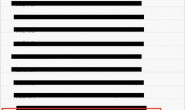请大牛指点
Android 自定义的进度条对话框,用AlertDialog实现,本人写一个测试程序,效果很正常,图片如下
http://fhr.luckcome.com/temp/01.png
但是将它移植到本人的项目后,对话框的宽度就不是设定的 match_parent 了,而且还多了一个背景框,不知道这个背景框是哪来的,都是自定义的,测试代码怎么就是正常的
http://fhr.luckcome.com/temp/02.png
下面是进度条对话框布局文件
Android 自定义的进度条对话框,用AlertDialog实现,本人写一个测试程序,效果很正常,图片如下
http://fhr.luckcome.com/temp/01.png
但是将它移植到本人的项目后,对话框的宽度就不是设定的 match_parent 了,而且还多了一个背景框,不知道这个背景框是哪来的,都是自定义的,测试代码怎么就是正常的
http://fhr.luckcome.com/temp/02.png
下面是进度条对话框布局文件
<LinearLayout xmlns:android="http://schemas.android.com/apk/res/android" android:layout_width="match_parent" android:layout_height="match_parent" android:background="@drawable/dialog_bg1" android:orientation="vertical" > <TextView android:id="@+id/progressTitle" android:layout_width="wrap_content" android:layout_height="wrap_content" android:background="#0000ff" android:text="" /> <ProgressBar android:id="@+id/progressBar" android:layout_width="match_parent" android:layout_height="wrap_content" android:layout_marginLeft="10dp" android:layout_marginRight="10dp" android:layout_marginBottom="10dp" style="?android:attr/progressBarStyleHorizontal" android:progressDrawable="@drawable/my_progress_bar" android:max="100" android:visibility="visible" /> </LinearLayout>
下面是自定义的对话框类
package com.example.dialog20141118;
import android.annotation.SuppressLint;
import android.app.Activity;
import android.app.AlertDialog;
import android.content.Context;
import android.view.LayoutInflater;
import android.view.View;
import android.widget.ProgressBar;
import android.widget.TextView;
public class MyProgressDialog {
private Context context;
private AlertDialog mDialog;
private View mView;
private LayoutInflater mInflater;
private AlertDialog.Builder mBuilder;
private TextView mTextView;
private String title;
private ProgressBar mProgressBar;
private int mProgress=0;
private int mSecondaryProgress=0;
private int mMax=100;
private int mVisibility=0;
/**
* 构造函数
* @param context
*/
@SuppressLint("InflateParams")
public MyProgressDialog(Context context,String title) {
this.context = context;
this.title = title;
mInflater = LayoutInflater.from(context);
mView = mInflater.inflate(R.layout.my_prgdlg_layout, null);
mBuilder = new AlertDialog.Builder(context);
mBuilder.setView(mView);
mDialog = mBuilder.create();
mDialog.setCanceledOnTouchOutside(false);
mProgressBar = (ProgressBar)mView.findViewById(R.id.progressBar);
mTextView = (TextView) mView.findViewById(R.id.progressTitle);
mTextView.setText(title);
}
/**
* 显示对话框
*/
public void show(){
mDialog.show();
}
/**
* 销毁对话框
*/
public void dismiss() {
mDialog.dismiss();
}
/**
* 进度条显示进程
*/
Thread progressRun = new Thread() {
@Override
public void run() {
while(true) {
mProgressBar.setProgress(mProgress);
}
}
};
/**
* 测试进程,配合 progressRun 进程使用
*/
Thread progressCount = new Thread() {
@Override
public void run() {
while(mProgress < 100) {
mProgress++;
try {
Thread.sleep(100);
} catch (InterruptedException e) {
// TODO Auto-generated catch block
e.printStackTrace();
}
}
dismiss();
}
};
/**
* 启动进度条显示刷新进程
*/
void progressStrart() {
progressRun.start();
// 测试用,使进度条跑动
progressCount.start();
}
/**
* 获取对话框标题内容
* @return
*/
public String getTitle() {
return title;
}
/**
* 设置对话框标题
* @param title
*/
public void setTitle(String title) {
this.title = title;
}
/**
* 获取 进度条进度值
* @return
*/
public int getmProgress() {
return mProgress;
}
/**
* 设置进度条进度值
* @param mProgress
*/
public void setmProgress(int mProgress) {
this.mProgress = mProgress;
}
/**
* 获取第二进度的进度值
* @return
*/
public int getmSecondaryProgress() {
return mSecondaryProgress;
}
/**
* 设置第二进度的进度值
* @param mSecondaryProgress
*/
public void setmSecondaryProgress(int mSecondaryProgress) {
this.mSecondaryProgress = mSecondaryProgress;
}
/**
* 获取进度的满量程值
* @return
*/
public int getmMax() {
return mMax;
}
/**
* 设置进度的满量程值
* @param mMax
*/
public void setmMax(int mMax) {
this.mMax = mMax;
}
}
解决方案
5
你继承AlertDialog 在onCreate方法中setContentView试下
5
要设置style
View diaView=View.inflate(this, R.layout.dialog, null);
dialog=new Dialog(AuthorizeActivity.this,R.style.dialog);
dialog.setContentView(diaView);
dialog.show();
View diaView=View.inflate(this, R.layout.dialog, null);
dialog=new Dialog(AuthorizeActivity.this,R.style.dialog);
dialog.setContentView(diaView);
dialog.show();
5
添加个style:
<resources>
<style name=”dialog” parent=”@android:style/Theme.Dialog”>
<item name=”android:windowBackground”> @android:color/transparent </item>
</style>
</resources>
然后改一下这里的代码:
mBuilder = new AlertDialog.Builder(context,R.style.dialog);
<resources>
<style name=”dialog” parent=”@android:style/Theme.Dialog”>
<item name=”android:windowBackground”> @android:color/transparent </item>
</style>
</resources>
然后改一下这里的代码:
mBuilder = new AlertDialog.Builder(context,R.style.dialog);
5
mBuilder.setView(mView,0,0,0,0); 用这个参数的 去填充对话框




